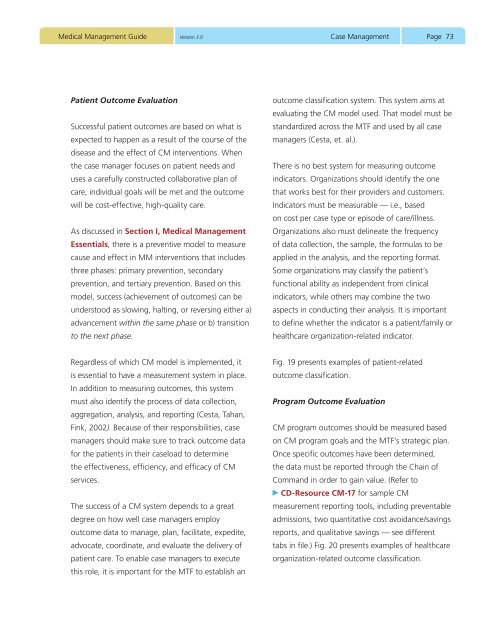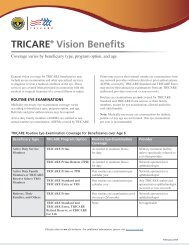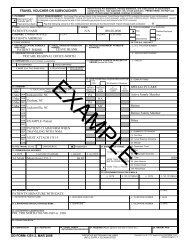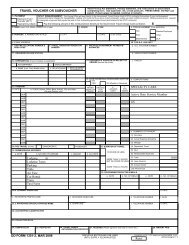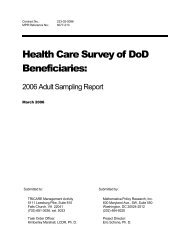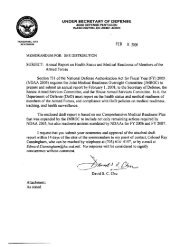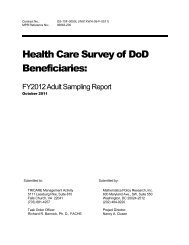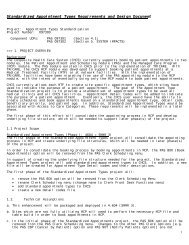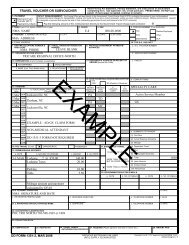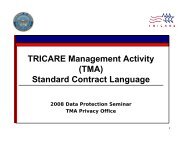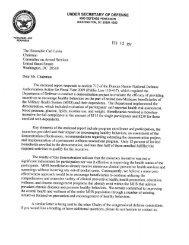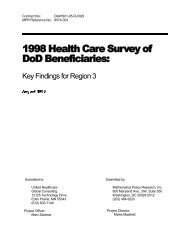Medical Management Guide, 2009, Version 3.0 - Tricare
Medical Management Guide, 2009, Version 3.0 - Tricare
Medical Management Guide, 2009, Version 3.0 - Tricare
- No tags were found...
You also want an ePaper? Increase the reach of your titles
YUMPU automatically turns print PDFs into web optimized ePapers that Google loves.
<strong>Medical</strong> <strong>Management</strong> <strong>Guide</strong><strong>Version</strong> <strong>3.0</strong>Case <strong>Management</strong>Page 73Patient Outcome EvaluationSuccessful patient outcomes are based on what isexpected to happen as a result of the course of thedisease and the effect of CM interventions. Whenthe case manager focuses on patient needs anduses a carefully constructed collaborative plan ofcare, individual goals will be met and the outcomewill be cost-effective, high-quality care.As discussed in Section I, <strong>Medical</strong> <strong>Management</strong>Essentials, there is a preventive model to measurecause and effect in MM interventions that includesthree phases: primary prevention, secondaryprevention, and tertiary prevention. Based on thismodel, success (achievement of outcomes) can beunderstood as slowing, halting, or reversing either a)advancement within the same phase or b) transitionto the next phase.outcome classification system. This system aims atevaluating the CM model used. That model must bestandardized across the MTF and used by all casemanagers (Cesta, et. al.).There is no best system for measuring outcomeindicators. Organizations should identify the onethat works best for their providers and customers.Indicators must be measurable — i.e., basedon cost per case type or episode of care/illness.Organizations also must delineate the frequencyof data collection, the sample, the formulas to beapplied in the analysis, and the reporting format.Some organizations may classify the patient’sfunctional ability as independent from clinicalindicators, while others may combine the twoaspects in conducting their analysis. It is importantto define whether the indicator is a patient/family orhealthcare organization-related indicator.Regardless of which CM model is implemented, itis essential to have a measurement system in place.In addition to measuring outcomes, this systemmust also identify the process of data collection,aggregation, analysis, and reporting (Cesta, Tahan,Fink, 2002). Because of their responsibilities, casemanagers should make sure to track outcome datafor the patients in their caseload to determinethe effectiveness, efficiency, and efficacy of CMservices.The success of a CM system depends to a greatdegree on how well case managers employoutcome data to manage, plan, facilitate, expedite,advocate, coordinate, and evaluate the delivery ofpatient care. To enable case managers to executethis role, it is important for the MTF to establish anFig. 19 presents examples of patient-relatedoutcome classification.Program Outcome EvaluationCM program outcomes should be measured basedon CM program goals and the MTF’s strategic plan.Once specific outcomes have been determined,the data must be reported through the Chain ofCommand in order to gain value. (Refer toCD-Resource CM-17 for sample CMmeasurement reporting tools, including preventableadmissions, two quantitative cost avoidance/savingsreports, and qualitative savings — see differenttabs in file.) Fig. 20 presents examples of healthcareorganization-related outcome classification.


